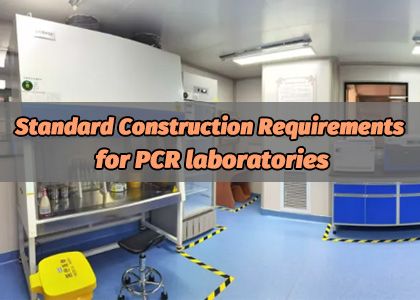
PCR laboratories are mainly located in the laboratory and pathology department, which is characterized by a large increase in trace amounts of DNA. PCR is a conventional method for molecular biology research and experiments, and is applied to: AIDS detection, hepatitis B, avian disease, cancer gene detection and diagnosis, animal and plant quarantine, cosmetics, food hygiene testing, genetically modified crops and genetically modified microorganisms detection.
PCR laboratory, also known as gene amplification laboratory, is the basis of molecular diagnosis, but also the necessary place for PCR experiments. In recent years, due to the continuous development of the field of molecular diagnostics, how to plan a qualified laboratory is the first problem that every PCR practitioner must encounter.
In nucleic acid testing, the construction of gene amplification laboratory has been paid more and more attention, because it plays a crucial role in the reliability, accuracy and safety of test results. Over the years, Yuanqi Health has done many cases of PCR laboratory construction, and summarized the following points for attention in PCR laboratory construction projects according to experience.
PCR laboratory layout
In principle, the clinical gene amplification laboratory is divided into four separate working areas: reagent storage and preparation area, specimen preparation area, amplification reaction mixture preparation and amplification area, and amplification product analysis area. In order to avoid cross-contamination, access to each work area must strictly follow a single direction, that is, only from the reagent storage and preparation area → sample preparation area → amplification reaction mixture preparation and amplification area → amplification product analysis area. The transfer of reagents and samples between each experimental area should be carried out through the pass box.
How can we design a qualified PCR laboratory? Simply put, each district is independent, pay attention to the wind direction, adapt to local conditions, facilitate work, and pay attention to the receipt of specimens.
Laboratory air conditioning ventilation system design and pressure control
PCR laboratories do not have strict purification requirements, but in order to avoid the possibility of cross-contamination between various experimental areas, it is advisable to use the air flow organization form of all feed and all exhaust. At the same time, the proportion of air supply and exhaust should be strictly controlled to ensure the pressure requirements of each experimental area.
1. Reagent storage and preparation area: The main operations in this experimental area are the preparation of stored reagents, the packaging of reagents and the preparation of the main reaction mixture. Reagents and materials for preparation of specimens shall be transported directly to this area and shall not pass through other areas. Reagent raw materials must be stored in the area and prepared into the required storage reagents in the area. There are no strict requirements for the control of airflow pressure in this area.
2. Sample preparation area: The main operations in this area are the preservation of clinical specimens, the extraction and storage of nucleic acids (RNA, DNA), and the synthesis of cDNA when they are added to the amplification reaction tube and the determination of RNA.
The pressure gradient in this area is required to be positive relative to the neighboring area to avoid aerosol pollution entering this area from the neighboring area. In addition, due to the possibility of aerosol contamination during operation, unnecessary movement in the area should be avoided.
3. Preparation of amplification reaction mixture and amplification area: The main operation in this area is DNA or cDNA amplification. In addition, the addition of prepared DNA templates and synthetic cDNA(from the sample preparation area) and the preparation of reaction mixes from the main reaction mixture (from the reagent storage and preparation area) can also be carried out in this area. In nested PCR assay, the reaction tube must usually be opened after the first round of amplification, so nested amplification has a high risk of contamination, and the second addition must be carried out in the local area.
The pressure gradient in this area is required to be negative relative to the adjacent area to avoid the leakage of aerosols from this area. To avoid pollution caused by aerosols, unnecessary movement within the area should be minimized. Individual operations such as adding samples should be carried out in the ultra-clean table.
4. Amplification product analysis area: The main operation in this area is the determination of amplified fragments. This area is not available if a fully automatic closed analytical instrument is used.
This area is the most important source of amplification product contamination, so the pressure gradient in this area is required to be negative pressure relative to the neighboring area to avoid the diffusion of amplification products from this area to other areas.